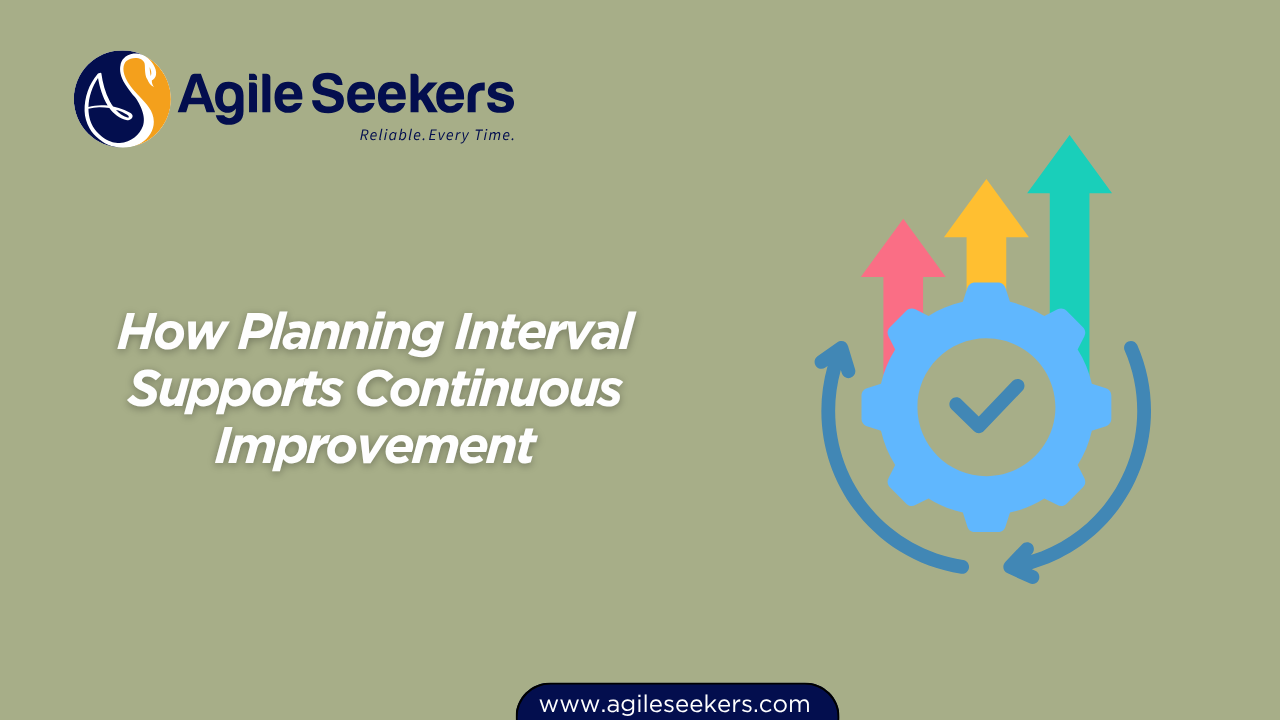How Planning Interval Supports Continuous Improvement

Let’s get the basics out of the way. A Planning Interval (PI) is a fixed period (usually 8-12 weeks in SAFe) where teams come together to set objectives, align on priorities, and decide what they’re delivering. It’s not just a big meeting; it’s the heartbeat of steady improvement for teams running on SAFe or any scaled agile setup.
But continuous improvement? That’s where the real magic happens.
2. The Feedback Loop: Built Right Into the Cadence
Here’s the thing—every Planning Interval naturally creates a rhythm for feedback and learning. At the end of each PI, teams look back and ask:
-
What worked?
-
Where did we get stuck?
-
What should we try differently next time?
This structured, predictable cadence gives teams room to experiment, reflect, and adapt. It’s much more than a box-ticking exercise. The timebox itself forces you to pause and think: “Are we better than we were last time?”
For anyone serious about Leading SAFe Agilist Certification Training, understanding this feedback loop is essential. It’s at the core of what makes SAFe work.
3. Retrospectives: Where Continuous Improvement Gets Real
Let’s be honest—daily standups don’t cut it for deep improvement. The PI retrospective, though? That’s where teams can actually dissect big patterns, not just yesterday’s hiccups.
-
Systemic Issues: You spot recurring bottlenecks.
-
Process Experiments: You agree to try something new in the next PI—maybe a different way of splitting work or how you estimate.
-
Action Items: Improvement isn’t wishful thinking; it’s a backlog item with an owner and a due date.
It’s not theory—it’s action. If you want to see continuous improvement in the wild, sit in on a real PI retrospective.
4. Aligning Improvement with Business Goals
Continuous improvement for its own sake? That’s not enough. In PI planning, teams tie improvement efforts directly to business goals. If delivery slipped last PI, maybe you address that by tweaking your Definition of Done. If customer value isn’t landing, maybe you shift how you gather feedback.
Connecting improvement work with real outcomes is a big reason why SAFe Product Owner Product Manager POPM Certification highlights the role of outcome-based thinking in every interval.
Check out the Scaled Agile Framework’s take on business agility for more on how this alignment drives results.
5. Real-Time Metrics: Fuel for Change
Continuous improvement isn’t just talk. Teams use metrics during each PI to make data-driven decisions:
-
Velocity and Predictability: How reliably do we deliver?
-
Flow Metrics: Where are the bottlenecks?
-
Quality Indicators: Are defects trending up or down?
By checking these numbers every PI, teams see trends—not just snapshots. That means you’re not “gut-feeling” your way forward; you’re adjusting based on facts.
Teams taking SAFe Scrum Master Certification dig deep into using these metrics as levers for improvement.
For a solid read on agile metrics, check out Atlassian’s guide to agile metrics.
6. Empowered Teams: Ownership Drives Improvement
Continuous improvement stalls when only leaders care. PIs encourage every team member to raise issues and propose experiments. There’s a reason SAFe Advanced Scrum Master Certification Training leans so heavily into facilitation and empowerment. When teams own their improvement journey, you get genuine, grassroots change.
-
Ownership: Teams identify the problems that actually matter to them.
-
Experiments: Teams choose what to try—no one’s just following orders.
-
Accountability: Teams track their improvement items each PI.
7. Leadership’s Role: Enable, Don’t Dictate
Leaders set the tone, but they don’t micromanage. During PIs, the best leaders:
-
Clear obstacles out of the team’s way.
-
Champion improvement work, even if it means short-term discomfort.
-
Invest in coaching and training, like SAFe Release Train Engineer Certification Training, to make sure teams have what they need to grow.
This isn’t just top-down—it’s leadership in service of the team. More on that in Harvard Business Review’s write-up on continuous improvement culture.
8. Inspect and Adapt: The Crown Jewel of the PI
SAFe nails this with the Inspect & Adapt (I&A) event at the end of every PI. This isn’t just a formality. Here’s what goes down:
-
Teams demo actual value delivered.
-
Everyone reviews metrics together.
-
Teams brainstorm improvement stories—then pick one or two to tackle next PI.
This is the system holding itself accountable, not just talking about change but actually doing it.
9. Small Changes, Big Results
Here’s what people often miss: Continuous improvement is rarely about grand transformations. It’s dozens of little tweaks—every single PI—that add up. Maybe it’s adjusting how stories are written. Maybe it’s a new way of syncing with business stakeholders. Over a few intervals, these compound.
This is why high-performing Agile Release Trains and teams invest in habits, not one-off events. Leading SAFe Agilist Certification Training covers this exact mindset: improvement as a journey, not a project.
10. Final Thoughts: Making Continuous Improvement Part of the Culture
Let’s cut to the chase: Planning Intervals give teams the structure, safety, and rhythm to actually get better—not just talk about it. You get built-in check-ins, honest retros, measurable experiments, and real leadership support.
If you’re ready to make continuous improvement real (not just a slide deck mantra), double down on your PI discipline. Make retrospectives count. Connect improvement to real business value. Celebrate wins—then raise the bar again.
That’s how Planning Intervals actually drive continuous improvement—one disciplined step at a time. No buzzwords needed.
Also read - Tips for Facilitators to Maximize Planning Interval Value
Also see - How To Use Breadth Versus Depth Planning During PI Planning




















